Indian Volunteers in the Great War East African Campaign
- Home
- World War I Articles
- Indian Volunteers in the Great War East African Campaign
In August 1914 the Volunteer units of the Indian Defence Force were recruited from white and mixed-race members of the civilian community whose expectations were that they would only be used operationally within India for local or home defence. However, on the declaration of war, several members of Volunteer units wished to serve overseas and their willingness allowed the Indian authorities to assemble three units for service in East Africa. An artillery battery, a Maxim Gun Company and a railway defence section were dispatched along with a few specialists such as signalers.
The North-Western Railway Volunteers
This unit initially supplied a 12-pdr, 12-cwt gun and a four-man detachment (plus five followers) for an armoured train. The men and their gun sailed from India with Indian Expeditionary Force ‘B' arriving off Tanga, German East Africa (GEA), in November 1914. During the two days of fighting onshore the detachment remained on board along with the two Railway Companies, Sappers and Miners, that it was supporting, and withdrew to Mombasa with the re-embarked survivors of the British defeat at Tanga.
After escort duties on the Uganda Railway and a short spell of action on the British East Africa (BEA) coast the gun team was sent north to Kisumu on Lake Victoria. Here the gun was mounted on the vessel Winifred that was being used for transport duties on the lake. The gun came into action against ground targets during the successful British raid on Bukoba, GEA, in June 1915. At this time the North-Western Railway Volunteers appear to have been reinforced and converted into a six-Maxim Gun detachment in preparation for the invasion of GEA In the latter half of 1915 a 2-gun section was deployed at Mzima Springs in the Tsavo Valley. The railway gun was left in the hands of the Royal Navy on Lake Victoria and was moved onto the vessel Kavirondo.
During the battle for the Latema-Reata ridge line on 11 March 1916 the North-Western Railway Volunteers under Lieutenant HPC Browne were attached to the Indian Volunteer Maxim Gun Company (see details below), being used as No 4 Section of that Company. After this successful action, which opened the door into GEA for the British, the North-Western Railway men appear to have been used as an independent machine gun detachment and they probably served in-theatre longer than any other Indian Volunteer unit.

Three Distinguished Conduct Medals (DCM) appear to have been issued to North-Western Railway Volunteers and the citations in the London Gazette [LG] give an idea of the conditions under which these men fought:
No. 94 Sergeant AE McNevin (attached Bharatpur Imperial Service Infantry)
For conspicuous gallantry and devotion to duty, In the face of heavy enemy fire he handled his gun with great coolness and remained himself in action with it after the majority of his team had become casualties. His courageous determination was most praiseworthy.
No. 56 Corporal C Lowe
For conspicuous gallantry and devotion to duty. His behaviour and coolness under fire was very marked. In one action he set a fine example to his gun team, keeping his gun going after his team had nearly all become casualties, he himself being wounded later.
No. 98 Pte C Boardman
He worked his gun until his team had been reduced to two men. He was also successful in getting his gun out of action on being rushed by the enemy. He collected the remaining gun porters and returned to the firing line, where he remained all night until the section was relieved next day.
Temporary Lieutenant W.T. Biscoe was mentioned in despatches.
The Commonwealth War Graves Commission (CWGC) commemorates two North-Western Railway Volunteers on the Dar Es Salaam British and Indian Memorial: No. 63 Private Godfrey Rupert Williams and No. 122 Private HH Webb. Two others have known graves: No. 109 Private S Joseph is buried in the Dar Es Salaam CWGC War Cemetery; No. 7656 Private L. Hockley is buried in Mombasa Mbaraki CWGC Cemetery.
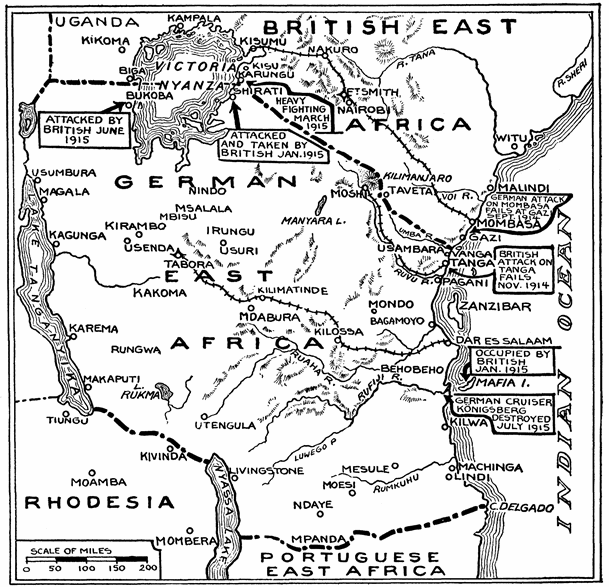
The Calcutta Volunteer Battery
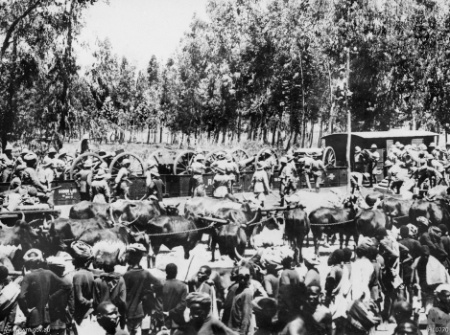
The first reinforcements sent to East Africa from India started arriving in September 1914. They were the units of Indian Expeditionary Force ‘C' commanded by Brigadier-General JM Stewart. General Stewart had requested a field artillery unit and so a battery was formed from members of the Calcutta Artillery Volunteers. This six-gun 12-pdr 6-cwt (the old horse-artillery gun) battery used ox transport. Although the oxen moved slowly they were more reliable than motor transport when the African rains fell and the roads and tracks turned into thick mud. Major Graham Kinloch commanded the battery.
Although known as The Calcutta Volunteer Battery, the official designation was No 8 Battery. The battery was initially deployed with one section detached at Voi whilst the remainder of the battery moved to the Kajiado area south of Nairobi to defend the most likely invasion route for German forces. At Voi, 100 miles north of Mombasa, a military railway was being constructed westwards towards GEA. In 1915 the complete battery was deployed to support the construction of this railway.

On 11 February 1916 the battery came into action and fired 330 rounds during the failed British attack on Salaita Hill (this was the first occasion in East Africa when British artillery used telephone lines running back to the guns from Forward Observation Officers, and No 8 Battery's lines were frequently cut by motorcyclists and horsemen).
Exactly one month later the battery was in action again during the ultimately successful British attack on the Latema-Reata hills, firing 363 shrapnel rounds.
During the advance by General Smuts' British forces down the Pangani River, No. 8 Battery was in Force Reserve but it was brought into action on the Lukigura River on 24 June 1916 when over 30 enemy were killed and over 50 captured - a rare achievement in the African bush where the enemy usually slipped away at the last moment.
By now the Calcutta Volunteers must have been suffering, along with the other non-African units, from the debilitating and often fatal effects of the tropical diseases that were prevalent. As well as ‘fever' or malaria, dysentery, black-water fever, snake and scorpion bites, and jiggers (insects that burrowed under toenails) constantly caused medical problems, whilst crocodiles and other wild animals were ready to attack the oxen during watering periods in rivers. In addition, General Smuts' almost total disinterest in logistics was leading to a constant shortage of rations that affected both morale and physical efficiency.
In November 1916 No. 8 Battery was moved by sea, south to Kilwa, a harbour in between Dar Es Salaam and the Portuguese border. As fighting intensified around Kibata to the northwest of Kilwa the Battery's Ammunition Column was sent forward to support the other artillery units in action there. The Calcutta Volunteer Battery had for a time been the only British field artillery unit in East Africa, and after the arrival of South African field batteries it had been a useful reserve artillery unit, but now the artillery staff wished to convert all field artillery batteries to the South African 13-pdr gun. On 18 February 1917 No. 8 Battery left the Kilwa area and it is probable that the Calcutta Volunteers then handed in their equipment and returned to India.
One Calcutta Artillery Volunteer was awarded the DCM.
No. 86 Bombardier JV Seivwright
For conspicuous gallantry when bandaging a wounded man under fire and removing him to a place of safety. He also went back across the open for water for the forward observation post under heavy fire.
Five Calcutta Artillery Volunteers were Mentioned in Despatches in the LG of 30 June 1916.
Temporary Major G Kinloch
2nd Lieutenant WM Browning
No. 46 Bombadier H Binning
No. 74 Acting Bombadier J Emeny
No. 121 Gunner JP Tocher
No. 96 Gunner FA Pacey is commemorated on the Nairobi British and Indian Memorial. No. 24 Gunner T Turner is buried in Nairobi South CWGC Cemetery. No. 45 Corporal W Dawson is buried in Moshi CWGC Cemetery, Tanzania.
Individual Indian Volunteers
Two Volunteers can be traced through LG announcements, the first being awarded a DCM, and the second a mention.
No. 9 Corporal (Motor Cyclist) HG Cooper, The Southern Provinces Mounted Rifles (Madras)
For conspicuous gallantry on 14 July 1915 at Mbuyuni (East Africa) when he carried messages on foot under a very heavy fire to and from the firing line and, though severely wounded, with great coolness and bravery continued his work and delivered all his messages safely. His devotion to duty was most marked.
No. 40868 Fitter CA Digman, Bombay Volunteer Artillery
Mentioned in Despatches - LG of 7 March 1918
One Volunteer, Jemadar Jaganath Venkataswami, 36th Bengal Nagpur Railway Battalion is commemorated on the Dar Es Salaam British and Indian Memorial. It is unusual to find an Indian officer with this rank, evidently a Tamil, on the strength of an Indian Defence Force unit
The Indian Volunteer Maxim Gun Company
Fortunately the Public Records Office in London holds the War Diary of this unit (except for December 1916), allowing one to follow its progress from formation to return to India. Authority was given to form the unit on 12 September 1914 and the headquarters of The Bombay Volunteers was chosen to be the assembly point. Captain FN James, 104th Rifles and Adjutant of The Bombay Volunteers, was selected to command the new company and Sergeant Major AA Wale, a British Army instructor with the Bombay Volunteers was selected as the Company Sergeant Major.
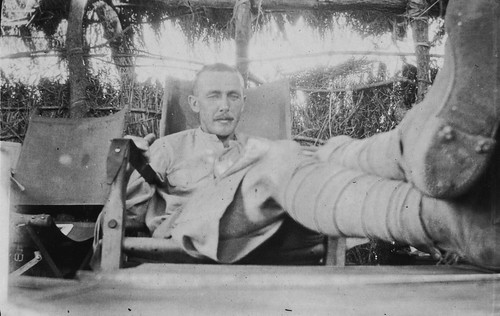
On 15 September, two Maxims, 16 machine gun mules with saddlery and six drabies (men who tended the mules) were sent to Bombay from Jhansi, followed a day later by a similar party from Rawalpindi. The saddlery was new and panels had to be stuffed and holes punched into straps.
Volunteers arrived for attestation from The Bangalore Rifle Volunteers and the Bombay, Lucknow, Mussoorie and Nagpur Volunteer Rifles. The men were equipped with rifles and 1903 pattern bandolier equipment, issued with mekometers (range finders), field glasses, ammunition and tentage and sent to embark on the MT Bandra on 18 September. The naval convoy sailed 48 hours later and a daily training routine of physical training, gun instruction and instrument skills commenced. In the evenings lectures were given to non-commissioned officers and first aid skills were practised. Most of the men were unfamiliar with the Maxim; one range practice had been fired in Bombay and now the guns were fired over the side of the ship. Medical inoculations were brought up to date.
The Company was organized into four sections. The Section Commanders were 2nd Lieut. H. Agrup (Bombay), Lieut EA Macnee (Nagpur), Sergeant WJ Cockle (Punjab) and Lieut CH Tresham (Mussoorie). Each section contained 18 non-commissioned officers and men. On 3 October disembarkation commenced in Kilindini Harbour, Mombasa, where the Company was split into two groups: Nos 3 and 4 Sections entrained for Nairobi and then moved to the GEA border area south of Nairobi, whilst Nos. 1 and 2 Sections and Company HQ were trans-shipped to the SS Duplex for operations at Gazi near the GEA border.
Coming in to action
Two German field companies had moved up the coastline from Tanga in GEA with the intention of attacking Mombasa. Arab and African troops of the British forces had blunted this assault but the enemy was still probing through the coconut plantations around Gazi. After being landed from lighters the Volunteers quickly came into action and learned how to fire bursts into trees and clumps of bush to clear out concealed enemy soldiers. CSM Wale, a renowned rifle shot, exposed himself to an enemy sniper in order to locate him, and then brought him out of a tree with one shot. But the Germans were not the only enemy on this insect-ridden coastline. By the end of November half the Company was sick with fever, and No. 71 Private Humphreys (Bombay) had died in Mombasa Hospital. His grave is in Mombasa Mbaraki CWGC Cemetery, Kenya. Captain James appealed for his men to be withdrawn as the enemy had retreated towards GEA, and in early December Nos. 1 and 2 Sections were moved from the coast to Nairobi which is situated 5,500 feet above sea level.
The Nairobi climate was beneficial, but sadly not for No. 58 Pte H.M. Walker (Bombay). He died in Nairobi of Blackwater Fever on 5 January. His grave lies in Nairobi (South) CWGC Cemetery, Kenya. Nairobi was only enjoyed for a fortnight. A new battle on the coast sent Nos. 1 and 2 Sections back down to Mombasa and finally to the Umba Valley on the GEA border - one of the most unhealthy locations in BEA. Two .450 Maxims were given to the Company for this action, complete with carriage mounts. The guns seldom fired in anger as the enemy had withdrawn again, and the two sections were back in Nairobi in mid-February. Fever was thinning out the ranks and men were medically evacuated to India in March 1915, a replacement draft arriving from the Cawnpore Rifle Volunteers. The Company was now reorganized into three Sections.
Longido
Meanwhile to the north Nos. 3 and 4 Sections had been involved in a serious fight across the GEA border. As a diversion aimed at attracting German troops away from Tanga whilst Indian Expeditionary Force ‘C' landed there, the British mounted an attack on the German garrison at Longido Mountain on 3 November 1914. This attack failed, as did the landing at Tanga, but two men from the Indian Maxim Volunteer Company were later awarded DCMs with identical citations:
No. 74 Corporal AJ Drake; No. 73 Pte EC O'Sullivan (both from Mussoorie)
For gallant conduct, coolness and ability during the engagement on 3 November, 1914, at Longido (East Africa). Whilst under heavy fire he handled his machine-gun very effectively against the enemy in their counterattack.
During 1915, detachments of the Company supported operations in the Lake Victoria and Kilimanjaro areas, and manned their Maxims as train guards on the Uganda Railway which was being targeted by enemy demolition parties. Two Volunteers were commissioned into the Indian Army Reserve of Officers and joined Indian Army units in East Africa: 2nd Lieut (former Sgt) SH Kearsey (Nagpur) joined the 63rd Palamcottah Light Infantry; 2nd Lieut (former Pte) GH Cooke (Bombay) was posted to the 130th Baluchis but attached to the 2nd Kashmir Rifles, an Imperial Service unit. CSM Wale was commissioned into the 2nd Bn The Loyal North Lancashires (regrettably he was later killed in France). Reinforcing drafts of Volunteers continued to arrive from India. In August the company was deployed to Maktau on the military railway line being constructed from Voi to the GEA border. Operational tempo increased as the Germans patrolled continuously in the area.
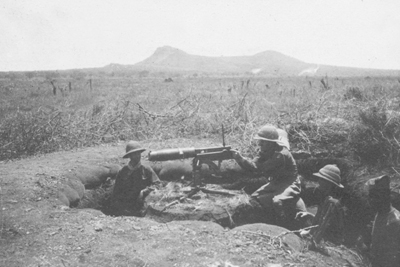
The push into German East Africa
In early 1916, massive numbers of South African reinforcements arrived in theatre and preparations were made for the invasion of GEA The Indian Volunteers now had friendly aircraft flying overhead and armoured cars trundling through the bush besides them. The company was issued with 20 First Line pack mules tended by a Conductor and six ‘Cape Boys' from the South African Service Corps. However, two more battles had to be fought on BEA soil and the Company shed blood in both of them.
During the abortive attack on Salaita Hill on 12 February 1916, all six guns of the Company came into action on the South African right flank, but when the assaulting white South African infantry broke and fled under the impact of a ferocious German Askari counter-attack, the Indian Volunteers were left in an exposed position. The Company withdrew in good order but Sergeant J Sinclair (Lucknow) was mortally wounded, dying soon afterwards. His grave is in Taveta CWGC Cemetery, Kenya. A gun porter was killed and a cook and two other porters wounded.
In order to clear a railway route into GEA the Latema and Reata hills had to be captured and the new British commander, General Smuts, mounted a set-piece Brigade attack. The Company deployed all six guns in support of 130th Baluchis who attacked Latema on 11 March. The Germans fiercely contested the hills and the battle ebbed and flowed throughout the afternoon and night until at dawn the enemy commander's nerve failed and he withdrew westwards into GEA Some of the intensity of the action can be assessed from this citation for a DCM later awarded to a member of the Company.
No. 65 Lance-Corporal M Fox (Bombay)
For conspicuous gallantry and devotion to duty. Although wounded in the foot early in the afternoon he continued to fight his gun, and after his section and gun commanders had been incapacitated, he took command, helped to carry his gun from place to place, and refused to leave till 8 pm, when he was ordered to the dressing station.
No. 62 Sergeant TO Parry (Bombay), No. 74 Cpl AJ Drake (Mussoorie) and No. 10 Private CW Tremenheere (Bangalore) were commended by Captain James for very professional conduct whilst under fire, along with Lieut HPC Brown of the North West Railway Volunteers (see above). Captain James was awarded a Military Cross.
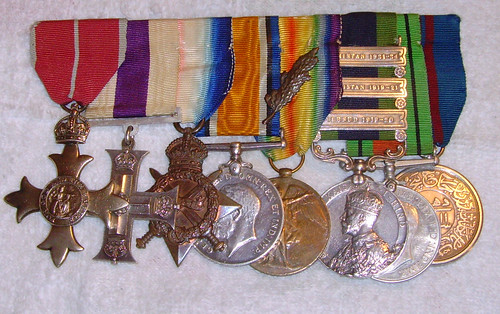
The Company lost two men killed on the slopes of Latema: 2nd Lieut RE Wilson (Bombay) and No. 50 Corporal TS Christopher (Mussoorie). Their graves lie in Taveta CWGC Cemetery, Kenya. Five men were wounded: No 57 Sergeant WR Clarke and Lance Corporal M Fox (both from Bombay), No. 8 Corporal C Bateman (Punjab), No. 48 Private J O'Loughlin (Mussoorie), and No. 99 Private Deakes (Cawnpore). Three of the faithful African gun porters were also wounded.
General Smuts now split his forces. After a halt during the heavy monsoon rains he advanced in May southeastwards with his infantry along the Moshi to Tanga railway line that ran down the valley of the River Pangani. General van Deventer was ordered to march with his South African 2nd Mounted Division on a route southwestwards to Kondoa Irangi. The Indian Volunteer Maxim Gun Company accompanied van Deventer's troops, but on foot. Van Deventer's men were ordered to march through the April rains which were the heaviest for many years, four inches of water sometimes falling in a day. The tracks quickly became quagmires that bogged down the motor transport, and only ox-drawn wagons could make decent progress. Rotting animal carcasses lined the route as tsetse-fly and climatic exposure took a toll. Many men fell sick from fever. The supply organization failed and the Volunteers were often reduced to half-rations or less after a day of struggling with the mules through the mud. This was a very hard march but the Indian Volunteers maintained their discipline. A fellow-volunteer machine gun unit recruited from white East Africans and marching on the same route displayed severe disciplinary problems when twenty-four men including non-commissioned officers refused orders to saddle-up one morning and were placed under arrest.
Actions in German East Africa
Six weary weeks after starting out, Company HQ arrived at Kondoa Irangi, where during June the Maxims supported the South African defence during attacks mounted by the Schutztruppe. In July two more Maxims were issued to the Company allowing the formation of a fourth section again, commanded by the recently commissioned Lieut AJ Drake DCM The company split into two detachments that marched with South African troops who were deployed to provide cover on van Deventer's western flank. Nos. 1 and 3 Sections moved west to Singida whilst Nos. 2 and 4 Sections looped north past lakes Balangida and Basotu to approach Singida from the north. Just short of Singida at Mgari, where the track climbed steeply up the side of the great Rift Valley, a small stone fort manned by German Askari blocked the route. No. 1 Section came into action there and fired 211 rounds. This caused enemy casualties and led to a quick surrender.
The Company was united at Singida and, leaving No. 2 Section there as part of a garrison, the remainder of the Company marched south to arrive on 12 August at Saranda on the German Central Railway. Camp was made at Kilimatinde eight miles to the south and picquet positions manned. Here No. 2 Section joined the Company from Singida and orders were received for all remaining original Volunteers to be returned to India (except officers) as their service was time-expired on 16 September. No. 15 Private R Nagaukar (Bangalore), one of the originals, died on the journey out of GEA and is buried in Taveta CWGC Cemetery, Kenya.
The month of October 1916 was spent in marching east along the Central Railway line to Dodoma where camp was made and the training of a recently arrived draft started. In November, thirty-seven Volunteers sent from India, but misemployed elsewhere in GEA, were located and brought to Dodoma. Personal equipments in the Company were now of differing patterns and clothing, which had not been re-supplied, and it was very ragged and deficient. Machine gun equipment could not be obtained.
The last operation
In November the Volunteers were attached to the 8th South African Infantry (SAI) and in December they marched south to Iringa. General Smuts had ordered van Deventer to attack southeast from Iringa to destroy a German unit on the Muganga Plateau. Four of the Company's Maxims went out on this operation. Violent storms broke and 28 Mountain Battery (MB), Indian Army, whom the Volunteers caught up with in early January, lost many mules that broke legs and necks slipping off the steep tracks. Several carriers collapsed and died whilst others despaired and jumped off cliffs, others deserted and several of these were shot by the King's African Rifles (KAR) Askari in the column. Several men were also lost to lightning strikes.
As usual on South African-led operations, although long-range contact was made, the envelopment plan appeared to be allowed to fail. A decisive battle was not forced and the Germans withdrew successfully. The failure of the ration re-supply became so bad that the South African troops were recalled to the Central Railway line by their divisional staff, but 28 MB, the Indian Volunteers, 17th Infantry (The Loyal Regiment), an Indian Army regiment, and the 4th (Uganda) KAR stayed on the plateau existing on short rations and steadily growing weaker. Papers in the National Archives, written by the Officer Commanding 28 MB, display his anger at the way South African troops plundered Indian Army rations being sent forward, looted his soldiers' personal kits left in brigade stores and treated hospitalized Indian soldiers with very limited concern. Attempts to bring these matters to light were treated with hostility by General Smuts and his staff.
Recall to India
On 7 February 1917 Captain James, now seriously ill, was carried away from the Company base at Boma Mzingi on a hammock stretcher. On the same day thirty-two of the Company mules were killed by a lightning strike. Lieutenant Macnee took over command, and a week later was ordered to march the Company back to Iringa where he was instructed to hand in his reserve ammunition and speedily move his company to Dar Es Salaam for repatriation to India. But this was easier said than done. The swollen Ruaha river, in places flooded up to eight miles wide, lay across the Company's path. Tracks were covered in water and the Volunteers and their carriers and gun porters splashed down the southern bank of the river. From a camp on the aptly named Mosquito Island a group of seven supply punts was observed being pushed upstream through the shallows by carriers. The NCO in charge of the punts agreed to move the Company across the deep river bed on his return journey, and then only three more miles of wading through swamps on the north bank was required before reasonably firm land was reached.
The Company arrived in Dar Es Salaam on 18 March 1917 and over the next few days handed in its guns and equipment. Lieut. Agrup returned to Taveta to locate the battlefield graves of Lieut Wilson and Corporal Christopher. Lieut Tresham returned to Dodoma with the Company's 139 long-suffering and loyal gun porters to hand them over to the Officer Commanding Carriers for allocation to 4 KAR, where they were to have the chance of becoming Askari. The surviving Volunteers embarked for India.
Conclusion
Very little recorded history of the Indian Volunteers can be found in archives. Hopefully one day the reference material that remains can be centrally collated by a determined researcher who will produce a history. But perhaps what this article can show is that the Indian Volunteers who went to East Africa to fight in hastily-formed units did not let their King-Emperor down. They displayed both high military standards and the resilience and discipline needed to deal with the extremely difficult conditions prevailing in the theatre. They were amongst the best of the British units serving in East Africa.
Footnote on war graves
The Volunteer commemorations mentioned above are those that the author has personally come across and photographed, and so there are bound to be more Indian Volunteer graves that he has yet to locate. The Commonwealth War Graves Commission does a really excellent job in maintaining war graves and memorials in East Africa. However in one respect the CWGC has been badly briefed about the Indian Volunteers. All the headstones of the buried Indian Maxim Gun Company Volunteers are carved with the crest of the British East Africa Protectorate and there is no reference to India on the stones. Correspondence with the CWGC has revealed that the Commission is working to a post-Great War policy document that designates the Indian Volunteer Maxim Gun Company and the Indian Telegraph Service as being East African Protectorate units. The author submitted to the Commission pages from the relevant War Diary proving that the dead men were members of an Indian military unit, but this submission was rejected. The Commission regards its policy documents as being infallible, as perhaps it needs to do to maintain consistency in its operations. If any reader knows of an approach that would result in the dead Volunteers being recognized by the Commission as having served in an Indian military unit, please advise the author via the editor.
Sources
Major D Jackson, India's Army; Official History of The War: Military Operations East Africa, August 1914 - September 1916
Brig-General JHV Crowe, CB, General Smuts' Campaign in East Africa
Ross Anderson, The Battle of Tanga 1914
The Naval Review: A Backwater. Lake Victoria Nyanza During the Campaign against German East Africa
National Archives WO95/5346 and WO95/5343: War Diaries of The Indian Volunteer Maxim Gun Company
National Archives WO95/5343: War Diaries of 2nd East African Division, No 2 Artillery Group
National Archives WO95/5337: War Diary of 1st East Africa Division, No 1 Artillery Group
The GH Cooke papers in the Liddle Collection, Leeds University, CAB 45/63: Comments on the draft unpublished second part of the Official History of the Campaign in East Africa
The London Gazette
RW Walker, Recipients of the Distinguished Conduct Medal 1914-1920
SD Pradhan, Indian Army in East Africa 1914-18.
Article contributed by Harry Fecitt
Related articles on the WFA's website:
The Advance Beyond Kilimanjaro German East Africa (now Tanzania), March 1916
The Battle for Latema-Reata Nek, British East Africa, 11 - 12 March 1916
The King's African Rifles at Kibata, German East Africa December 1916 to January 1917
Out on a Limb - the road through Tunduru: German East Africa, May to November 1917
Fighting for the Rufiji Crossing
Medo and Mbalama Hill, Portuguese East Africa, 12 - 24 April 1918





